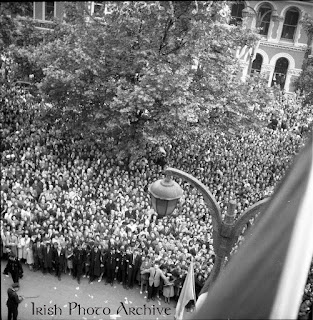This week marks the anniversary of President John F. Kennedy’s visitto Ireland in 1963. It was the first state visit to Ireland of a US president
during his first term in office, by the first solidly Irish-American and first
Catholic president of the USA, so Ireland wanted to make her visitor proud of
his heritage.
The Irish Photo Archive released a digital book on the Kennedy visit entitled President John F. Kennedy Visits in 1963, featuring all our special and unique photographs of the occasion. It is available on the iTunes Store, and can be downloaded or gifted to somebody on the opposite side of the planet within seconds. To access the digital book, click here.
The Irish Photo Archive released a digital book on the Kennedy visit entitled President John F. Kennedy Visits in 1963, featuring all our special and unique photographs of the occasion. It is available on the iTunes Store, and can be downloaded or gifted to somebody on the opposite side of the planet within seconds. To access the digital book, click here.
Kennedy came straight to Dublin from Berlin, where he had
addressed the crowds at the Berlin wall, making his famous ‘Ich bin ein
Berliner’ speech. The visit to Ireland, in contrast, would be an occasion of
mostly pleasure for the president, relatively free of political engagements but
packed full of opportunities for his legendary charm to shine through.
As the Kennedy motorcade wound through Dublin’s city centre
on the way to the Áras from the airport, the affection the Irish people had for
their visitor was obvious to all. Over 80,000 people were estimated to have
gathered on O’Connell Street alone, with more lining the streets along
Westmoreland Street, Dame Street, and down along the quays to the Phoenix Park.
Kennedy made a call down to the homestead of his ancestorsin Dunganstown, Co. Wexford, where his aunt Mary Ryan greeted him with a kiss
on the cheek. The Ryan family had laid on afternoon tea for Kennedy, who had
brought his sisters Jean and Eunice with him, as well as his bodyguards,
advisors, the ambassador to Ireland and a pack of reporters and cameramen (and
it was virtually all men in those days). But, despite the scrum surrounding
Kennedy, only the Lensmen photographer managed to get inside the cottage for
the more intimate family reunion.
Another poignant occasion during the Kennedy visit occurred
when he paid homage to the executed 1916 leaders at Arbour Hill. This was
another first achieved by Kennedy, as he was the first foreign head of state to
pay his respects at this memorial garden and therefore the first to acknowledge
their role in establishing an independent republic. It was also where Kennedy
saw the 36th Cadet Class under Lt Frank Colclough performed the
Queen Anne Drill, or the Funeral Drill, intended to honour the dead.
Kennedy seemed spellbound while the drill was going one, and
later commentated on their performance. Later, when back in the US and
reminiscing about the trip, he said his highlight was the ceremony at Arbour
Hill and that “those cadets were terrific”. He asked for a film of the drill be
made, so that it could be performed by the US ceremonial guards at the Tomb of
the Unknown Soldier. The cadets were to perform the drill once more for
Kennedy, and far sooner than anybody had anticipated, when Jackie requested
that the cadets be flown to Washington to perform at Kennedy’s funeral.
After the Arbour Hill ceremony, Kennedy was taken to
Leinster House where he would address both houses of the Oireachtas. After
Kennedy had signed the visitor’s book – a new Heads of State visitor’s book -
he entered the Dáil Chamber with Seán Lemass, James Dillon and Brendan Corish,
the leaders of the three main political parties in Ireland: Fianna Fáil, Fine
Gael and Labour. This was the first time a foreign leader would address both
Houses of the Oireachtas, and also the first time television cameras were
allowed inside the chamber.
On Kennedy’s return to the States, he spoke often about his
time in Ireland and how much he had enjoyed his visit. He had planned to come
back on a private holiday with his family, but was killed in Dallas five months
later. His death sent shockwaves throughout the world, but was particularly
devastating to the Irish, who still had precious memories of the young, vibrant
man that had charmed the population during his three days here.
All photos available @ Irish Photo Archive.
All photos available @ Irish Photo Archive.













